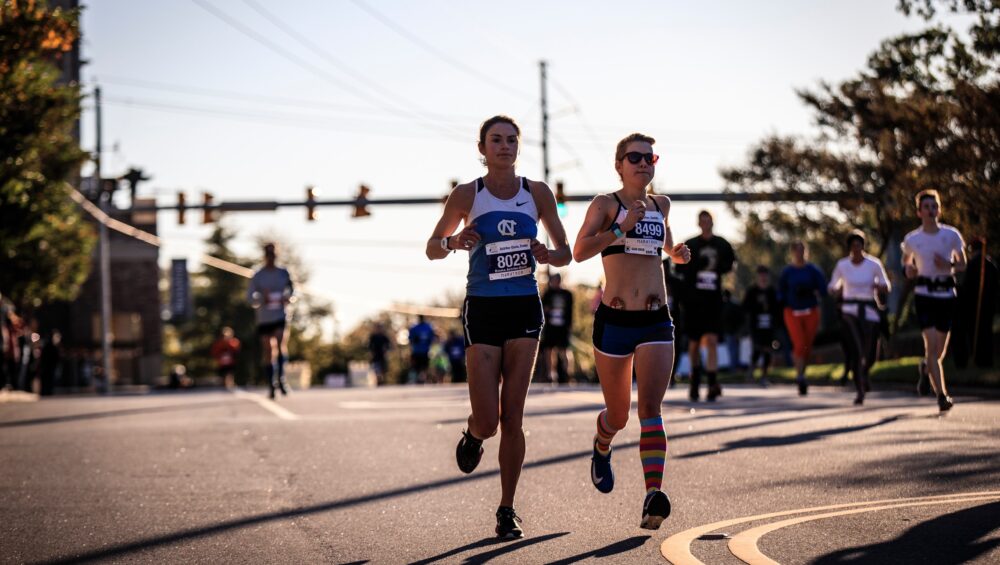When planning or organising a race event, choosing how the race numbers that your attendees or competitors will wear is one of the most important decisions to make. You have to consider the appearance of your racing bibs, the promotional aspect of the race numbers, and what material the bibs are made from.
When looking at the materials available to make your race bibs, you must consider how durable the number bibs need to be. Should they tear or not tear? And do you want to print onto them in multi-colour, and do they need to be water-resistant? There are lots of things to consider.
At The Race Bib Co., we make all our race bibs with Tyvek®, and in this article, we will explain why Tyvek race bibs are the perfect options for organising and managing your event.
What is Tyvek?
The Race Bib Co. is proud to use Tyvek to make all our race bibs, but you might not be familiar with what it actually is. Tyvek is a material produced by the company Dupont™and while you might not have heard of it, you will almost definitely have come into contact with it.
During the Covid-19 pandemic, Tyvek was used to create the much-needed PPE (personal protective equipment), from facemasks for the public to hospital gowns for medical professionals.
Tyvek is a 100% synthetic material made from high-density spun-bound polyethylene fibres. Tyvek looks like paper, with similar colouring and texture, but that’s where the similarity ends! Whilst paper would quickly deteriorate in most race environments, Tyvek is a much more durable option. A trustworthy option for eye-catching and functional race bibs.
Why Tyvek for Race Bibs
The core qualities of Tyvec are why The Race Bib Co. uses it for all our bibs. Whether we provide custom race number bibs for fun runs or race bibs with timing chips for processional races – triathlons, cycling events and more.
Durability
Tyvek is long-lasting and passes the ‘tear-test’. A perfect example is running race bibs when runners’ bibs are often attached with safety pins to the runner’s clothing. The standard paper bib would rip quite quickly, and the bib would be useless. However, Tyvek allows you to pin – and repin! – your race bib as often as needed without compromising the quality and security of the bib.
A vital factor is that Tyvek will not transfer or compromise the wearers’ clothing.
Water Resistance
In most race events, your race bibs must be water-resistant. As the race is under-way, the competitor – race bib wearer – will likely be sweating to some level. Whilst paper might survive this level of moisture, what it would not survive is rain or poor weather conditions. Tyvek race bibs will. Not only are Tyvek race bibs waterproof, but they repel moisture. Consider that competitors will often also shower themselves with water during races. Your bibs must be able to survive such treatment.
What is also important to remember with Tyvek race bibs is that when they are wet, they will dry back to their original state without compromising the visuals or security of the race bib.
Light Weight
Tyvek is lauded as an excellent material for race bibs because it combines the durability needed with also being incredibly lightweight. Whilst the weight of a race bib might not seem important, consider running a marathon or competing in an Iron Man. In extreme events like this, the comfort of the competitor is everything, whether you are a professional athlete or amateur.
Tyvek Race Bib Quality Comparison
Tyvek is considered to be the highest-quality material available for race bibs. As we’ve outlined above, its core elements perfectly match most sports events’ requirements.
To put it simply, when comparing Tyvek to paper, Tyvek will survive a lot of punishment and paper race bibs will not. Tyvek number bibs can be crumpled up, squashed around, soaked, and then returned to their original state. Visuals will still be intact, with the printing of logos and brands uncompromised by creasing.
This is, of course, important for any race sponsors featured on your race bibs. For example, The Race Bib Co. recently created race bibs with Virgin displayed as the sponsor. It is reassuring and essential that your race sponsors know that their branding or advertising will not be compromised and will be visible from start to finish.
Tyvek bibs can also be printed on both sides without compromising the quality of your number bibs. However, the blank inside of your race bib is often of value. You can easily write on Tyvek, and a racer’s contact information is often shared on the inside of their racing bib (“In case of emergency, please contact …”).
Tyvek and Race Bib Chips
Today, most races, from amateur fun runs to professional marathons and cycling races, require some timing element. One of the most efficient ways to coordinate this is to incorporate the timing element into a competitor’s race number bib. A timing chip within a racing bib coordinates the competitor’s start time when they cross the starting line, accurately follows them around the course through the various checkpoints and logs their finish time.
The durability of Tyvek makes it the perfect material for combining with racing microchips. It is reassuring for racers and event organisers to know that their data will not be compromised and have their results instantly available online for their team to follow.
Race Bib Sustainability
The final thing to highlight with Tyvek race bibs is that whilst it is a synthetic material, it is also 100% recyclable. DuPont’s current focus is on incorporating Tyvek in the circular economy. We are proud to be part of that movement to ensure that our race bibs are repurposed, reused, or recycled into new products.
So if you want to create durable, attractive race bibs and ensure you are providing a sustainable event, Tyvek race numbers with The Race Bib Co. are the right choice for you.
Ways we can help
At The Race Bib Co. we regularly work with organisers planning sporting events of all sizes. We are always happy to assist in anyway we can. Get in touch today by emailing hello@theracebibco.com.au
You can find out more about our company here.






